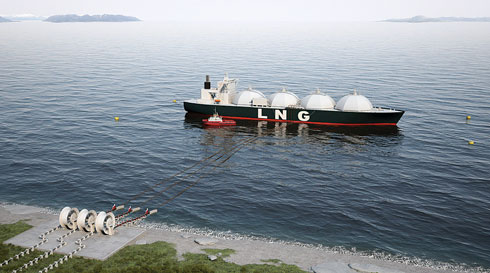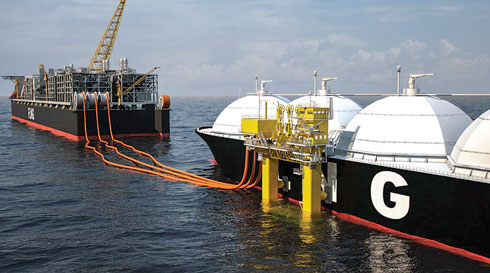Floating cryogenic hoses unlock new opportunities in LNG transfer
The LNG market is both growing and changing. According to a recent study, global demand for LNG is projected to increase by a factor of 50% by 2020, compared to 2014. Much of this demand is spurred by the fact that LNG is usable in multiple markets, regions and configurations, and is widely available.
At the same time, big changes are being seen in demand patterns for LNG, particularly gas power generation in the Asia-Pacific region. India is leading the charge, while China, Japan and Korea are both eyeing natural gas in a push to move away from high-polluting fossil fuels. In addition, remote regions of Indonesia and the Philippines are looking to LNG to fill the energy gap where access to the main grid is limited or unreliable, or where power generation capabilities are restricted. Reliable access to energy is vital to the success of economic growth in these remote regions, and LNG can play a key role in delivering sustained growth.
Clear acceleration in demand is seen for small- and medium-scale LNG. In delivering LNG to these remote regions, it is necessary to be able to split it into smaller load parcels. To accommodate this need, the global fleet of LNG carrier vessels is diversifying. Today, the world’s LNG fleet of around 500 vessels includes 26 FSRUs and 33 small-scale ships with a storage capacity of 30,000 m³ or less. These vessels have specialized capabilities in oil and gas transfer. To carry out these operations successfully, they require innovative and flexible transfer solutions to adapt to the requirements of both the cargo and the recipient. This requires moving away from solutions that had facilitated the transfer of coal or fuel oil.
Rethinking transfer operations. Traditional thinking has been that LNG vessels would moor at the dockside and use a jetty platform for ship-to-shore transfers, or use bridging arms for ship-to-ship transfers between an FSRU and a carrier, bunkering vessel or LNG-powered ship. Gas in its liquefied form presents a different challenge since it must be transported at a temperature of –163°C.
LNG transfer solutions require specialized cryogenic hosing to safely transfer LNG to regasification plants. In many cases, there will be a need for traditional jetties; however, due to the requirement for specialist cryogenic hoses for LNG transfer, more focus is being placed than ever before on hose technology and its capabilities.
Composite LNG hoses typically consist of multiple, unbonded, polymeric film and woven fabric layers encapsulated between two stainless steel wire helices—one internal and one external. Essentially, the film layers provide a fluid-tight barrier to the conveyed product, with the mechanical strength of the hose coming from the woven fabric layers. The number and arrangement of multiple polymeric film and woven fabric layers is specific to the hose size and application (Fig. 1).
 |
|
Fig. 1. Cryogenic floating hoses. |
The polymeric film and fabric materials are selected to be compatible with the conveyed product and the operating temperatures likely to be encountered. Insulated hoses can reduce boiloff by as much as 60%, equating to a savings of 10 BBtu of energy over the course of 500 transfers. The outer protective hose draws on flexible rubber-bonded hose technology, which is well known for its high resistance to fatigue and its ability to withstand harsh environmental conditions. The flexibility and high flowrates achievable with cryogenic technology mean that it increases the economic feasibility of power generation, terminal, and marine bunkering projects that are located away from existing infrastructure—particularly in areas where jetty-based transfer would be infeasible because of harsh conditions or environmental concerns (Fig. 2).
 |
|
Fig. 2. Cryogenic hoses in ship-to-shore configuration. |
Similarly, in offshore environments, cryogenic hose technology allows transfer to occur in deeper seas and in more challenging conditions. In comparison to traditional side-by-side transfer using loading arms, cryogenic hoses can be used in a tandem configuration, significantly increasing the distance between the vessels involved: approximately 100 m–150 m for FLNG-to-carrier transfers, and 300 m–500 m for carrier-to-FSRU offloading transfers. This distance plays an important role in mitigating the risk of collision, as does the fact that the high flowrates afforded by the technology significantly reduce the length of the transfer operation, further reducing risk (Fig. 3).
 |
|
Fig. 3. Tandem ship-to-ship offloading. |
Unlocking the transfer zone. A major advantage of hose-in-hose technology is that it can negate the need for fixed onshore infrastructures; a concrete platform onshore combined with hose transfer solutions offers an alternative that can be up to 80% more cost-effective for locations where fixed onshore infrastructure would be prohibitive.
Collaborations between hose manufacturers and transfer equipment manufacturers demonstrate how certain ship-to-shore operations can be further enhanced, as well as offer increased flexibility and a choice of transfer options. Floating transfer terminals or barges can be connected to the shore using cryogenic hoses, which can then be easily connected with a vessel using a transfer system on a barge. These solutions can be built, outfitted and commissioned offsite in parallel, with relatively light civil engineering activity, thereby reducing the overall time scale from contract award to first gas.
As a self-contained mobile unit, a floating barge or transfer unit can be readily adapted for alternative deployment in the event of local changes or a desire to move location entirely. A floating solution also allows for refuge to be sought in safe harbor during storms or hurricanes, for deep maintenance to be undertaken at a shipyard, and for integration with a variety of LNGC mooring configurations. Moreover, the barge is only used when transfer is underway, minimizing the impact on the environment. Crucially, it is also suited to smaller carriers, for which many existing docking facilities are not configured.
In conclusion, cryogenic hoses in floating configurations unlock new opportunities for LNG transfer, both at sea and in nearshore environments, reducing the risk of safety incidents and downtime, and lowering handling procedure times by as much as 60% in some instances. It is perhaps unsurprising that the prognosis for this technology is in rude health; a study conducted by Mordor Intelligence estimated that the global cryogenic equipment market would reach $23.5 B by 2021.
As LNG’s role in the global energy mix increases, it is imperative that transfer technology keeps pace. Cryogenic hose technology is demonstrating that transfer technology can match the ubiquity and flexibility of LNG fuel itself. GP
 |
Vincent Lagarrigue, Director of Trelleborg Oil & Marine, is an expert in crude oil offloading solutions and LNG offshore transfer, and has worked at Trelleborg for more than 10 yr. Mr. Lagarrigue handles the Oil & Marine group’s complete product range of oil and gas transfer systems, including solutions for FLNG and small-scale LNG applications. At Trelleborg, he has been responsible for the design and qualification of flexible bonded hoses for offshore crude oil transfer (e.g., oil offloading lines, reel systems) and LNG transfer. Mr. Lagarrigue holds an MSc degree in mechanical engineering from the French Institute for Advanced Mechanics (IFMA) in Clermont-Ferrand, and an Executive MBA degree in finance and entrepreneurship from the EMLyon Business School in Écully, France.




Comments